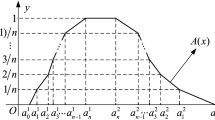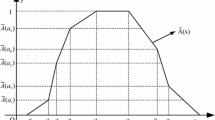Abstract
Based on the extensive operations of polygonal fuzzy numbers, a GA-BP hybrid algorithm for polygonal fuzzy neural network is designed. Firstly, an optimal solution is obtained by the global searching ability of GA algorithm for the untrained polygonal fuzzy neural network. Secondly, some parameters for connection weights and threshold values are appropriately optimized by using an improved BP algorithm. Finally, through a simulation example, we demonstrate that the GA-BP hybrid algorithm based on the polygonal fuzzy neural network can not only avoid the initial values’ dependence and local convergence of the original BP algorithm, but also overcome a blindness problem of the traditional GA algorithm.







Similar content being viewed by others
Explore related subjects
Discover the latest articles, news and stories from top researchers in related subjects.References
Buckley JJ, Hayashi Y (1994) Fuzzy neural networks: a survey. Fuzzy Sets Syst 66(1):1–13
Buckley JJ, Hayashi Y (1994) Can fuzzy neural nets approximate continuous fuzzy function. Fuzzy Sets Syst 61(1):43–51
Liu PY (2002) A new fuzzy neural network and its approximation capability. Sci China (E) 32(1):76–86
Liu PY (2002) Fuzzy neural network theory and applications [D]. Beijing Normal University, Beijing
He CM, Ye YP (2011) Evolution computation based learning algorithms of polygonal fuzzy neural networks. Int J Intell Syst 26(4):340–352
Wang GJ, Li XP (2011) Universal approximation of polygonal fuzzy neural networks in sense of K-integral norms. Sci China Inf Sci 54(11):2307–2323
He Y, Wang GJ (2012) The conjugate gradient algorithm of the polygonal fuzzy neural networks. Acta Electronica Sinica 40(10):2079–2084
Sui XL, Wang GJ (2012) Influence of perturbations of training pattern pairs on stability of polygonal fuzzy neural network. Pattern Recog Artif Intell 26(6):928–936
Chen Chuen-Jyh (2012) Structural vibration suppression by using neural classifier with genetic algorithm. Int J Mach Learn Cybernet 3(3):215–221
Zhang SW, Wang LL, Chen YP (2008) A fuzzy neural network controller based on GA-BP hybrid algorithm. Control Theor Appl 30(2):3–5
Dong LT, Robert M (2010) Genetic Algorithm-Neural Network (GANN): a study of neural network activation functions and depth of genetic algorithm search applied to feature selection. Int J Mach Learn Cybernet 1(4):75–87
Tobias F, Trent K, Frank N (2013) Weighted preferences in evolutionary multi-objective optimization. Int J Mach Learn Cybernet 4(2):139–148
Zhang JL, Zhang HG, Luo YH (2013) Nearly optimal control scheme using adaptive dynamic programming based on generalized fuzzy hyperbolic model. Acta Automatica Sinica 39(2):142–149
Mahapatra GS, Mandal TK, Samanta GP (2011) A production inventory model with fuzzy coefficients using parametric geometric programming approach. Int J Mach Learn Cybernet 2(2):99–105
Li QL, Lei HM, Xu XL (2010) Training self-organizing fuzzy neural networks with unscented kalman filter. Syst Eng Electron 32(5):1029–1033
Xue H, Li X, Ma HX (2009) Fuzzy dependent-chance programming using ant colony optimization algorithm and its convergence. Acta Automatica Sinica 35(7):959–964
Cao YJ, Wu QH (1999) Teaching genetic algorithm using MATLAB. Int J Electr Eng Educ 36(2):139–153
Qiao JF, Li M, Liu J (2010) A fast pruning algorithm for neural network. Acta Electronica Sinica 38(4):830–834
Kao CH, Hsu CF, Don HS (2012) Design of an adaptive self-organizing fuzzy neural network controller for uncertain nonlinear chaotic systems. Neural Comput Appl 12:1243–1253
Sui D, Fang X (2011) Optimization of PID controller parameters based on neural network. Comput Simul 28(8):177–180
Lin CM, Li MC, Ting AB, Lin MH (2011) A robust self-learning PID control system design for nonlinear systems using a particle swarm optimization algorithm. Int J Mach Learn Cybernet 2(4):225–234
Author information
Authors and Affiliations
Corresponding author
Additional information
This work has been supported by National Natural Science Foundation China (Grant No. 61374009)
Rights and permissions
About this article
Cite this article
Yang, Y., Wang, G. & Yang, Y. Parameters optimization of polygonal fuzzy neural networks based on GA-BP hybrid algorithm. Int. J. Mach. Learn. & Cyber. 5, 815–822 (2014). https://doi.org/10.1007/s13042-013-0224-y
Received:
Accepted:
Published:
Issue Date:
DOI: https://doi.org/10.1007/s13042-013-0224-y




